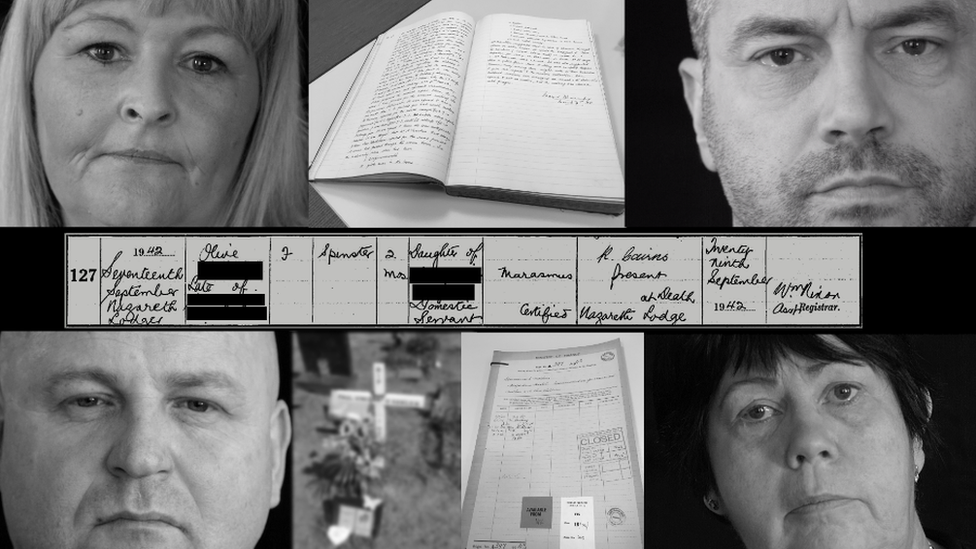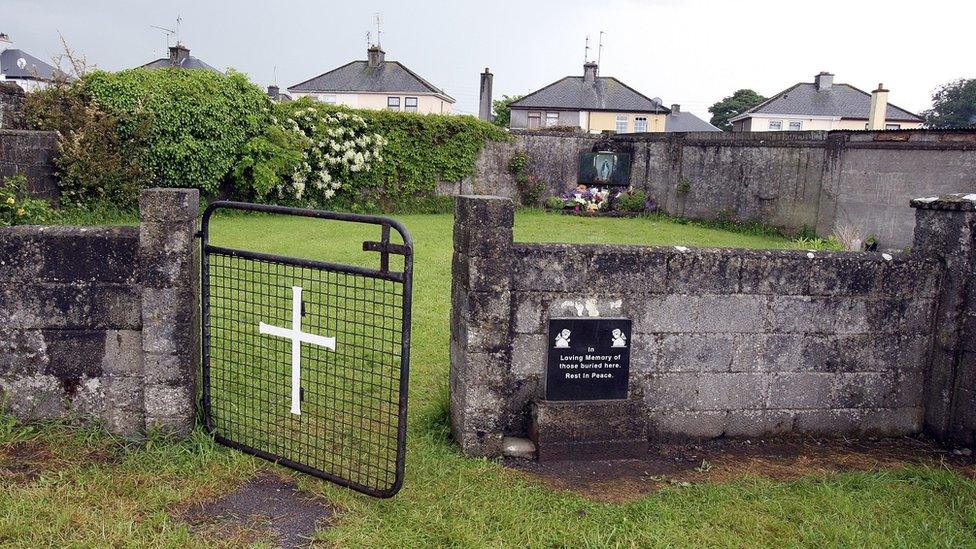Former residents call for NI mother and baby homes inquiry
- Published

The Detail website has spoken to former residents and examined archive records of the mother and baby homes
New research into infant mortality rates at former mother and baby homes in Northern Ireland has added weight to calls for a public inquiry.
The institutions housed women and girls who became pregnant outside marriage.
An investigative website, external has found that in 1942 the mortality rate of babies born outside marriage was twice that of those born to married parents.
The Detail's research also reveals that the deaths of many babies in the homes were caused by "severe malnutrition".
The website compiled its research by examining death certificates and archive files at the Public Record Office of Northern Ireland (PRONI), external.
It also analysed burial records for Milltown Cemetery, Belfast's biggest Catholic cemetery.
The Catholic Church's Down and Connor Diocese, which owns the burial records, said the website's revelations "add further to our shame".
"These findings demonstrate how, as a church and as a society, we have failed to protect the most vulnerable members of our community," a diocesan statement said.
Forced labour allegations
Not all of the homes were Catholic; some were run by the Church of Ireland and the Salvation Army.
Former residents of the Northern Ireland institutions are launching a campaign for a dedicated public inquiry into the treatment of woman and children at the homes.
Some of the girls, external who were sent to the homes were as young as 13, but most were older teenagers.
Many mothers who gave birth in the homes were excluded from Stormont's recent Historical Institutional Abuse (HIA) inquiry because it only focused on victims who were under the age of 18.
The campaign is being supported by the human rights organisation Amnesty International.
The Detail said Amnesty International is calling for a "proper human rights-compliant public inquiry" after it received allegations of "forced labour, arbitrary detention, ill treatment and the illegal adoption of babies in former mother and baby homes".

The Tuam home was demolished but a shrine was later erected on the site
Stormont's Executive Office recently set up a working group to look into allegations of abuse in mother and baby homes.
It is focusing on residents aged over 18 from mother and baby homes and Magdalene laundries who fell outside the remit of the HIA inquiry.
The group held its first meeting in March.
Human remains found
The harsh conditions in mother and baby homes have recently gained international attention due to the Tuam babies scandal in the Republic of Ireland.
Three months ago, an Irish public inquiry confirmed that "significant quantities" of human remains had been discovered at the site of a former home in Tuam, County Galway.
The Irish government agreed to set up the inquiry in 2014 after allegations about the deaths of 800 babies in Tuam and the manner in which they were buried.
The issue was brought to the fore by County Galway historian Catherine Corless, whose personal research into hundreds of death certificates raised questions over where the children had been buried.
Excavation of the site by the Mother and Baby Homes Commission of Investigation began in October 2016.
In March, investigators confirmed that human remains were found in "at least 17 of the 20 underground chambers which were examined".
The Tuam home operated from 1925 to 1961 and a child died in the home nearly every two weeks between the mid-1920s and 1960s.
Most of the deaths are believed to be from natural causes, as disease and high infant mortality were features of the institutions.
The building has since been demolished and in the 1970s, a housing estate was built on the land.
Former residents of mother and baby homes and their children, the Good Shepherd Sisters, the Salvation Army, the Sisters of Nazareth and Down and Connor Diocese have all confirmed to Detail Data that they would be willing to cooperate with a public inquiry if the Executive Office agrees to one taking place.
- Published4 March 2017
